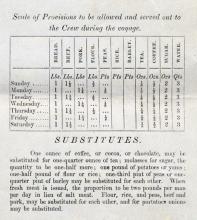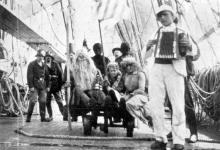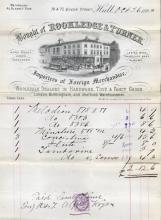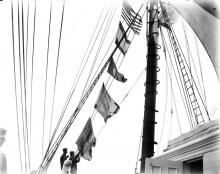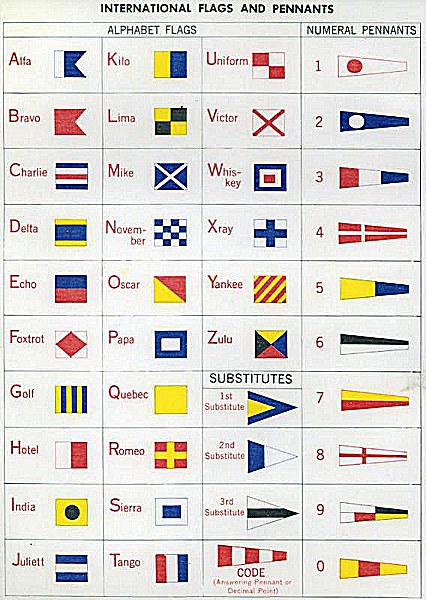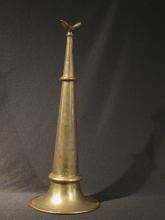Food, Leisure, and Communication at Sea
Food
Food aboard sailing ships was not like ours today. There was no refrigeration, so meat was preserved by salting or canning. Bread was often a very hard cracker called hard tackHard tack
A hard biscuit baked without salt made of wheat flour and water. It became very hard and would keep for a long time. While it could be made on ship, it was more commonly bought in barrels.. On American ships in the late nineteenth century, the government required that all seamen receive minimum daily provisions, including one pound of bread, one and a half pounds of beef or one and a quarter pounds of pork, an additional half pound of flour three times a week or a third of a pint of peas three times a week, one third of an ounce of tea, a half ounce of coffee, two ounces of sugar, and three quarts of water. Water was a concern; it could become rancid after sitting in casks for months. Provisions on American ships were much better than on British vessels.
A good cook could make palatable meals from this food, but there wasn’t a lot of variation over a long voyage. Seamen could tell the day of the week by the dinner. Fresh vegetables and fruits purchased at the beginning of the voyage had to be used in the first couple of weeks. Some ships carried chickens for eggs and an occasional fresh poultry dinner for the captain’s table. A pig might be killed for fresh pork, and some ships had a goat aboard to provide milk. On Sundays and perhaps one other day during the week the cook made special sweets, such as plum or dried apple duffDuff
A boiled or steamed pudding, usually containing dried fruit.. Much of the time, though, the crew’s food was limited to salt beef or pork, hard tack, dried peas, and bread made from sometimes weevily flourWeevil
A member of the beetle family that eats grain, fruit, or nuts. Weevily flour was flour into which weevils had gotten; weevils also got into prebaked ship's biscuit or hard tack..
The captain’s table, which included the captain, his wife and family, the mates, and any passengers, typically received more and better quality food than did the crew, although it was often the same basic menu.
To make hardtack:
Combine 3 1/2 cups white or whole wheat flour and 1/2 teaspoon salt in a bowl. Add cold water a spoonful at a time. When it sticks together, knead into a ball of dough. Let set for about 30 minutes. Roll out very thin. Place on baking sheet and score in wedges. Bake at 420 degrees for 30 minutes. Cool and allow to harden.
Leisure Time
Seamen commonly had some leisure time during the dogwatchDog watch
Two half watches of two hours each into which the period from 4 pm to 8 pm is divided. The purpose of dividing this watch into two parts is to produce an uneven number of watches in 24 hours, 7 instead of 6. This ensures that watchkeepers in ships, whether organized into two or three watches, do not keep the same watches every day. These two watches are known as the First Dog and Last Dog. and on Sundays. They could wash their clothes and themselves, repair clothing, write in their journals, read, smoke, play an instrument, sing, do some wood carving or fancy rope work, or tell stories. The American Seamen's Friend SocietyAmerican Seamen's Friend Society
Established in New York City in 1826. "To improve the social and moral condition of seamen, by uniting the efforts of the wise and good in their behalf; by promoting in every port boarding houses of good character, savings banks, register offices, libraries, museums, reading rooms and schools; and also the ministrations of the gospel, and other religious blessings."
Read more. loaned boxes of books to ships.
The seamen’s leisure time songs were known as forecastle songsForecastle songs fo'c'sle songs, forbitters
The sailors' songs sung in or on the forecastle when the men of a watch were off duty. They were not shanties, which were always working songs, but songs sung for recreation or entertainment. Also known as Fo'c'sle songs. or forebitters. Instead of shantiesSea shanty chantey
A rhythmic work song with a repeating chorus, often of a call-and-response format, used aboard ship to help with group tasks such as raising the anchor., they were popular ballads of the sea or shore. A seaman might pull out an accordion or fiddle to accompany the songs. The captain of a good ship might stock musical instruments in the ship’s store, called the slop chestSlop chest
Slops refers to ready-made clothing carried on board ship and issued to seamen, with the cost deducted from their wages., so the crew could purchase and use them aboard ship.
Communication at Sea
Before the days of radio, captains used code flags to send messages from one ship to another. After 1857, the Commercial Flag Code (later to become the International Flag CodeInternational Flag Code International code of Signals
A series of signal flags and pennants, one flag for each letter of the alphabet and one pennant for each number between 0 and 9.
Read more) standardized signal flagInternational Flag Code International code of Signals
A series of signal flags and pennants, one flag for each letter of the alphabet and one pennant for each number between 0 and 9.
Read more communication. Governments began issuing official numbers along with flag codes for each ship, with the US starting in 1868.
Sometimes two ships from Penobscot Bay would recognize each other, come closer, and communicate, first with flags, then with a speaking tubeSpeaking tube
Speaking tubes are tubes use to convey voice between compartments. On small ships a speaking tube might be fitted between the bridge or wheel house and engine room.. If the weather was fair, the ships might have a gamGam
A chat or conference among captains or sailors, ashore or at sea., an opportunity for the captains—and perhaps their wives—to meet and exchange mail or food.

